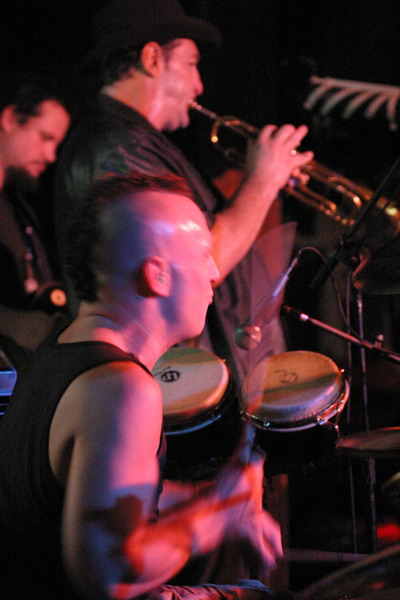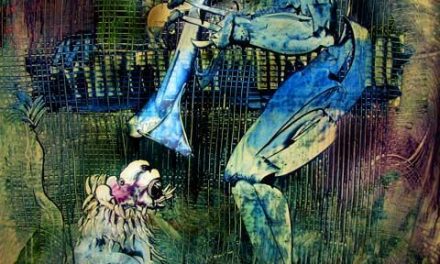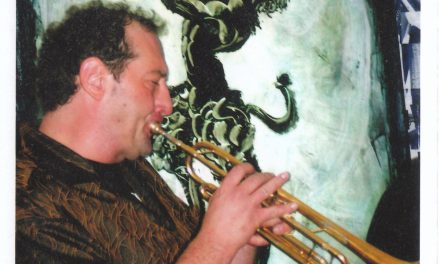Festival performers pushing boundaries of music
By Jeff Green
CNN
Thursday, September 29, 2005; Posted: 6:42 p.m. EDT (22:42 GMT)
http://www.cnn.com/2005/SHOWBIZ/Music/09/06/future.of.jazz/
(CNN) — The leader of one band taking part in the 48th Monterey Jazz Festival says his collection of rock stars sets out to create improvised “chaos” on stage — with the possibility of a “train wreck.”
“That’s the fun of it,” said Stephen Perkins, formerly the drummer with Jane’s Addiction and now the self-described “butt-mover” behind jazz outfit Banyan. “It’s also a great challenge.”
“Just like anybody improvising, some shows are going to be a train wreck, and some shows are going to be a bullet train,” said the 38-year-old Californian.
The core of Banyan’s eclectic group includes former Minutemen bassist Mike Watt — whom Perkins calls the “godfather of L.A. punk” — along with Wilco guitarist Nels Cline and trumpeter Willie Waldman, who has worked with rappers Snoop Dogg and Tupac Shakur.
Banyan is just one of the many acts — among more than 500 this year — that will be fulfilling a key part of the northern California festival’s mission statement: performances that “expand the boundaries of jazz.”
That is, whether the artists admit it or not.
“We’re not really trying to do something new,” said another Monterey performer, saxophonist Miguel Zenon. The Puerto Rican native’s newest album, “Jibaro,” is named for a style of folkloric “music from the mountains of the island.”
“We’re not doing anything purposely trying to break rules. It just happens to be what it is,” said the 28-year-old Zenon, who lives in New York.
“Even though we have a lot of respect for the past, we’re always looking forward,” he said.
International influence
While jazz may be “uniquely American,” as the festival’s statement says, Zenon typifies what he calls a growing wave of international influence that is evident at this year’s event.
“This is going to play a very important part in this music that people call jazz in the future,” he said. “Jazz is expanding, and it’s becoming kind of a global thing.”
That movement already has started, Zenon said, with American musicians incorporating influences from all over the world.
Guitarist and singer Doug Wambel said he considers that part of his long-term goal. Wambel said he takes his inspiration from Duke Ellington, who took his band all over the world and wrote music influenced by his travels.
“He was first and foremost an American jazz musician, but he was trying to incorporate the music of the world,” said Wambel, a 32-year-old Tennessean who lives in Connecticut.
But what sets Wamble’s band apart, he said, “is that we incorporate a lot of influences from other forms of American music, particularly gospel and Delta blues.”
Like Zenon, Wamble said he doesn’t set out to innovate — only to improve.
“I don’t believe that innovation is found,” he said. “I believe that it finds you.”
He acknowledged, though, that his music is not the trendiest in the New York jazz clubs. There, he said, artists “pursuing a very mathematical approach to music” get the most attention.
Celebrating diversity
Evolving for more than a century, jazz has never been confined by American borders. And the music world is shrinking fast these days, said pianist and composer Jon Jang.
“With technology and globalization, things are moving quicker,” said Jang, a 51-year-old Californian.
The foundation of American music has been African-American spirituals, Jang said.
“The greatest music in our country has been created by people who were not from here and were brought here as slaves against their will,” he said.
In an increasingly diverse society, he said, much of the great new work will come from people who come from elsewhere but choose to be part of the United States, with varying levels of assimilation into existing American music.
Jang said his own music involves placing Chinese folk songs in the jazz or symphonic worlds.
At Monterey, Jang’s seven-piece group will perform what he said is “Chinese music on paper, but it sounds like jazz.”
Jang credits Tim Jackson, who took over as festival general manager in 1993, for helping to keep the lineup exciting.
“Tim Jackson’s artistic vision celebrates the diversity of all the voices in jazz,” Jang said.
Backing Jackson’s vision is the nonprofit organization’s 15-member board of directors, which includes Hollywood actor-director and jazz lover Clint Eastwood.
The international influence, Jackson said, “will continue to make inroads into jazz, and I think that’s a good thing. I think it keeps the music fresh and interesting.”
An event as large as the Monterey Jazz Festival could not survive without big-name artists, such as 2005 performers Tony Bennett and Branford Marsalis, Jackson said.
But the festival also is “very conducive to variety and experimentation,” he said, with seven stages of differing sizes offering audiences a wide array of performers and styles.
“Our audience is expecting us, as professionals in this industry, to be able to discern what’s new and interesting,” he said, adding that many of those new performers grow to become established favorites.
Jackson pointed to Joshua Redman and Benny Green as artists who were nurtured in the festival’s education programs as high-schoolers and exposed to its audiences on their way to gaining wider fame.
This year’s student performers might learn something watching Perkins, who said that “jazz really doesn’t have any boundaries.”
The Banyan leader said two of his “heroes,” saxophonist Herman Green and guitarist Calvin Newborn, will play with him on stage after arriving from Memphis, Tennessee, the night before. They will play without a rehearsal.
“It could go from a swing feel to a real primitive tribal thing and into some kind of chaos, all in one moment,” said Perkins, who described jazz as his first love.
Another Banyan member will be on stage to been seen and not heard — interpretive painter Norton Wisdom.
“He’s kind of feeding off what we’re doing visually and vice versa,” Perkins said.






Recent Comments